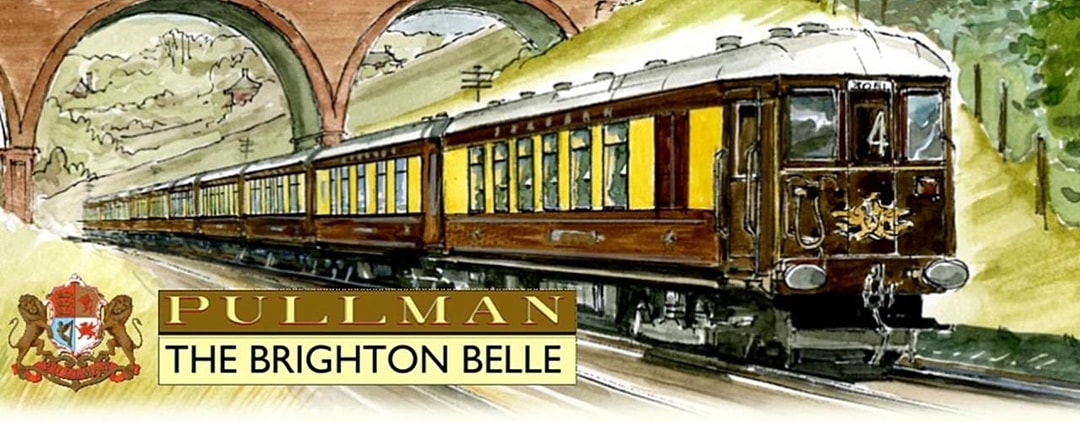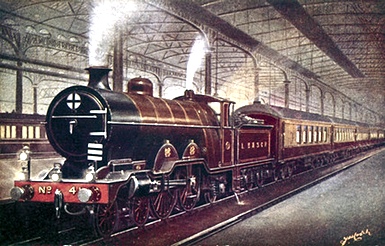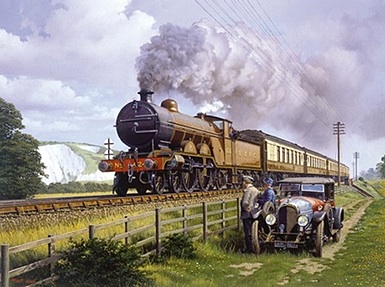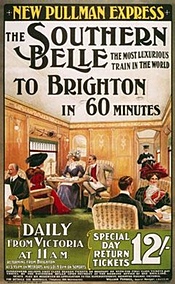
The Brighton Belle became one of the world’s best known and loved trains. Yet when it commenced service in 1934, the 53 mile (82 kilometer) line between London and Brighton had had a Pullman service for the best part of fifty years. Somehow, Brighton seemed to be an odd location to select a route for the country’s first frequent and truly luxury train. Brighton possessed a curious mix of residents: True it had its upmarket populace but the town had grown rapidly in Victorian times and had assumed its mantle of London by the Sea. Brighton was both a destination but had regular commuter traffic to the capital. Andrew Martin in his book Belles & Whistles describes the London, Brighton & South Coast Railway (LBSCR) as a ‘snobbish outfit’ who did not want to be known solely for carrying third class excursionists. The provision of a Pullman service meant that it could keep its prosperous customers.
Following an inaugural run on 5 December 1881 a Pullman service was developed that offered an upper class drawing room atmosphere in which passengers could relax in restful surroundings and in more spacious compartments. The Pullman offering provided innovation in rail travel (for a price) which was over and above the so-called first class service provided by the main railway companies; in cold weather the Pullman car’s interior was comfortably warm, thanks to a stove which made foot warmers unnecessary, toilet and wash basin facilities were provided, and a polite request would bring tea and freshly-prepared sandwiches all delivered by uniformed staff in attendance. These elements comprised the complete package of romance, luxury and personal service. The LBSCR London to Brighton Pullman was the first complete Pullman train.
One of the original four Pullman cars, Beatrice, is accredited as being the first railway carriage in the world to be electrically lit. On a trial trip in October 1881, Messrs Pincaffe and Lachlan, engineers of the French Fauré Accumulator Company, switched on the lights in the first tunnel and kept them on all the way back from Brighton to London. Since the train made several unadvertised stops, the Frenchmen rather feared the lights would go out before the train could arrive. This didn’t happen, much to annoyance of gas engineers who were busy promoting established gas technology to the railways. Gas companies rather conveniently overlooked the fact that escaping gas invariably turned railway accidents into infernos, by setting the smashed woodwork of the carriages ablaze – something that was going to occur for sometime in to the 20th century. For Fauré who designed the equipment it was a triumph but also for George Pullman, who naturally introduced lighting to his American Pullman stock.
Pullman services continued on the Brighton route with occasional variations until changes in stock. In 1888 three dedicated Pullman cars were joined by two matching six-wheeled railway vans known as Pullman pups, one housing a dynamo providing power for lighting. This facility was additionally provided on prestigious boat train services to the continent where passengers also paid a premium fare. The Brighton Pullman service was officially known as the Pullman Limited Express and the Pullman Limited – a non-stop service. On 2 October 1898 a new Pullman service was introduced for the Brighton line known as the Brighton Limited although it had to wait until 1899 to appear in official timetable and accompanying marketing literature. The Sunday only service (which ran from October to June) together with the daily unnamed Pullman service became so popular further changes were on the horizon.
 In 1906 the first of three new thirty five ton wood panelled Pullman coaches appeared on the route. These were named Ena, Princess Patricia and Duchess of Norfolk and were painted for the first time in the umber or white and chocolate brown livery which was to be later adopted as a standard colour scheme by LBSCR. Two years later in 1908 the British Pullman Palace Car Company was purchased by Sir Davidson Dalziel (Later Lord Dalziel of Wooler) to be operated as his own private company. He financed the purchase of new rolling stock through another of his companies – the Drawing Room Car Company. A new train, a new owner and a new dashing Edwardian age required a new name. The Southern Belle was born although there is some dispute as to when it ran for the first time – either 1st or 8th November 1908. However, it was now a seven-car train operating seven days per week, all year round and billed as ‘the most luxurious train in the world’ designed to encourage first class traffic to Brighton. From 1910 the frequency of journeys was increased to twice daily on Monday to Friday services. It was also the first Pullman train to be built in England. The coaches were double bogie twelve-wheelers with elliptical rather than clerestory roofs, internal mahogany panelling, fine soft coloured carpeting, damask silk blinds and settees in green morocco. Further Pullman cars were built to support demand for specialist train services.
In 1906 the first of three new thirty five ton wood panelled Pullman coaches appeared on the route. These were named Ena, Princess Patricia and Duchess of Norfolk and were painted for the first time in the umber or white and chocolate brown livery which was to be later adopted as a standard colour scheme by LBSCR. Two years later in 1908 the British Pullman Palace Car Company was purchased by Sir Davidson Dalziel (Later Lord Dalziel of Wooler) to be operated as his own private company. He financed the purchase of new rolling stock through another of his companies – the Drawing Room Car Company. A new train, a new owner and a new dashing Edwardian age required a new name. The Southern Belle was born although there is some dispute as to when it ran for the first time – either 1st or 8th November 1908. However, it was now a seven-car train operating seven days per week, all year round and billed as ‘the most luxurious train in the world’ designed to encourage first class traffic to Brighton. From 1910 the frequency of journeys was increased to twice daily on Monday to Friday services. It was also the first Pullman train to be built in England. The coaches were double bogie twelve-wheelers with elliptical rather than clerestory roofs, internal mahogany panelling, fine soft coloured carpeting, damask silk blinds and settees in green morocco. Further Pullman cars were built to support demand for specialist train services.
 Lord Dalziel had plans to maximise his investment in Pullman when in 1915 he caused a sensation by introducing third class Pullman cars for a new type of customer who wanted a treat but felt out of place in first class. With a third class ticket it was possible to travel on any of the many inexpensive day excursions from London to Brighton. For most people this meant once installed on a Pullman service in one of the opulent third class seats, the day-excursionist for a modest supplementary fare of one shilling and sixpence, could enjoy the same impeccable service as that of first class.
Lord Dalziel had plans to maximise his investment in Pullman when in 1915 he caused a sensation by introducing third class Pullman cars for a new type of customer who wanted a treat but felt out of place in first class. With a third class ticket it was possible to travel on any of the many inexpensive day excursions from London to Brighton. For most people this meant once installed on a Pullman service in one of the opulent third class seats, the day-excursionist for a modest supplementary fare of one shilling and sixpence, could enjoy the same impeccable service as that of first class.
 There were changes to the running order during the period of WW1. By March 1919 the Southern Belle resumed as a Sunday service. Pullman services were suspended during the coal strike of spring 1921 but resumed again without problems. By July 1924 the Southern Railway had come into being and this was reflected in a broader and more inclusive service; first class Sunday only service and first and third class service at all other times. The Southern Belle remained a steam hauled service until line electrification which drew power from a ‘third’ live conductor rail – the route being completed over a four year period in 1933. The Southern Electric as the system was snappily called, evolved under the direction of Sir Herbert Walker, the general manager of the Southern Railway. His board’s business strategy was to electrify suburban lines – a process that had been begun by the LBSCR before WW1. They had used overhead wires but the Southern adopted the third rail option as a more convenient and less expensive solution to push electrification to the coast. Brighton however, was not going to be deprived of its Southern Belle after over half a century of profitable service.
There were changes to the running order during the period of WW1. By March 1919 the Southern Belle resumed as a Sunday service. Pullman services were suspended during the coal strike of spring 1921 but resumed again without problems. By July 1924 the Southern Railway had come into being and this was reflected in a broader and more inclusive service; first class Sunday only service and first and third class service at all other times. The Southern Belle remained a steam hauled service until line electrification which drew power from a ‘third’ live conductor rail – the route being completed over a four year period in 1933. The Southern Electric as the system was snappily called, evolved under the direction of Sir Herbert Walker, the general manager of the Southern Railway. His board’s business strategy was to electrify suburban lines – a process that had been begun by the LBSCR before WW1. They had used overhead wires but the Southern adopted the third rail option as a more convenient and less expensive solution to push electrification to the coast. Brighton however, was not going to be deprived of its Southern Belle after over half a century of profitable service.
 In response to the opportunity of the electrified line Lord Dalziel ordered a complete new set of Pullmans which were built by Metro-Cammell Carriage & Wagon Company of Birmingham. From the front the third class motor parlour brake cars looked just like the stock used elsewhere on Southern’s electrified lines but they had no through corridors. They were also the heaviest coaches used in Britain at the time weighing in at 62 tons but they were finished in Pullman’s corporate umber and chocolate brown branding and bore the Pullman badge below the driver’s windows – known as the ‘motorman’. The parlour brakes contained four large electric motors each sufficient to power the heavy train (especially with a full complement of passengers) but still sufficient space to incorporate luggage compartments – passengers still travelled with heavy trunks and suitcases in the 1930s. Lord Dalziel’s company also anticipated greater usage of the Brighton Belle electrified service so the third parlour and motorised brake parlours were built with slightly cramped two plus two seating in contrast to two plus one on other steam-hauled Pullman trains.
In response to the opportunity of the electrified line Lord Dalziel ordered a complete new set of Pullmans which were built by Metro-Cammell Carriage & Wagon Company of Birmingham. From the front the third class motor parlour brake cars looked just like the stock used elsewhere on Southern’s electrified lines but they had no through corridors. They were also the heaviest coaches used in Britain at the time weighing in at 62 tons but they were finished in Pullman’s corporate umber and chocolate brown branding and bore the Pullman badge below the driver’s windows – known as the ‘motorman’. The parlour brakes contained four large electric motors each sufficient to power the heavy train (especially with a full complement of passengers) but still sufficient space to incorporate luggage compartments – passengers still travelled with heavy trunks and suitcases in the 1930s. Lord Dalziel’s company also anticipated greater usage of the Brighton Belle electrified service so the third parlour and motorised brake parlours were built with slightly cramped two plus two seating in contrast to two plus one on other steam-hauled Pullman trains.
So ‘the Southern Belle is dead – long live the Brighton Belle’ might have been the station announcement as the Victoria to Brighton steam-hauled Pullman ended its days in June 1934. The Brighton Belle was the world’s first regular Pullman all-electric service although the ‘first’ accolade might have gone to the Golden Mountain Pullman Express of the MOB – a short lived service which began in 1931 and lasted only for one season. The Brighton Belle immediately became the country’s premier electric train service and at once the most famous electric multiple-unit (EMU) in the world. The 5-BEL (its official Southern Railway designation) EMU was officially renamed by Margaret Hardy, the Brighton mayor on 29th June of 1934. Indeed, it simply became known as the Belle (there were in fact three sets of five cars) characterised by plush decor, deep armchairs and pink lampshades and for providing a regular and timely non-stop service to the south coast in style. The Brighton Belle was different to the vintage Pullman carriages first introduced to its other mainline prestige competitor – the Golden Arrow. The Brighton Belle introduced a new lexicon for train travel – ‘Art Deco and Jazz-Modern’ as these adjectives described the new Pullman train’s surroundings. The route to Brighton meant that the Brighton Belle was also a main-line seaside special. It was the ultimate party train, a train for late-risers and promoted for party outings and evenings by the sea. The Brighton Belle offered a slightly decadent luxury but as Andrew Martin refers to in his book Belles & Whistles ‘but with a demotic touch’.
The Brighton Belle thus began its legendary existence destined to outlive all the other Belle Pullman services; by this time Southern Railway management had introduced the Bournemouth Belle to the west, the Kentish Belle to the south east coast resorts of Margate and Ramsgate and the Golden Arrow had acquired a new rake of steel-sided Pullman coaches. The Brighton Belle with its initial three-trip Monday to Saturday and two-trip Sunday scheduled services became its jewel in the crown. In later years the frequency of trips increased to six and four respectively and once the service became housed in Brighton two additional trips were built into the timetable making eight Monday to Saturday journeys each way. The Brighton Belle had become renowned for its punctuality as a 60 minute non-stop service; it had entered into folk-lore. The service also became extremely popular with Brighton based theatricals as they could rely on its timings to get them to and from work in London. In the days before celebrity culture the Belle was a train to be seen on – a kind of ‘autograph album on wheels’ accorded by the Daily Telegraph.
The Brighton Belle’s longevity in some part was due to its wartime history. With the outbreak of war in 1939 the Brighton Belle, in common with all other titled trains, had their title and destination roof boards removed. Unit 3052 was damaged by bombing at Victoria station on 9 October 1940 and taken out of service. After a first short withdrawal for the ‘the national emergency’ the Brighton Belle began running again, albeit with rationed food and customers as well as staff who had been up all night on duty in the Home Guard. Subsequent bombing made it necessary to withdraw all Pullman cars in May 1942 and hide them in unlikely places for their own protection. The Brighton Belle service was eventually reinstated following repair to unit 3052 on 6 October 1947.
The Brighton Belle entered into nationalised British Railway (BR) operation the following year and began a long period of almost uninterrupted and a relatively ‘quiet life’ service. The wartime break and the less intensive use of stock (consisting of three sets of units) allowed one of the units to provide a Sunday only Eastbourne Pullman service until 1957. However, by the early 1960s the old lady was beginning to show her age. In 1967 the Pullman Division had passed into BR hands and a ‘corporatisation’ process had begun. The three sets of five car Pullman units were refurbished and repainted in the standardised BR blue and grey livery much to the chagrin of many. The Pullman cars lost their names and numbers and the name Brighton Belle was painted on the lower facia of the cars with BR’s logo replacing the Pullman badge. This was the last stage of life for the Brighton Belle as the service was gradually wound down. It became a cause célébre when in 1969 Lord Olivier found he could no longer receive grilled kippers for breakfast – these were reinstated following an outcry in the national press. However, closure of the Pullman service was inevitable; protests were noisy and many but even such celebrities could do nothing to postpone the eventual demise of the luxury train. As Michael Williams in his book The Trains Now Departed ruefully comments ‘no more grilled kippers and steaming pots of coffee at breakfast on the Brighton Belle’.
The train was withdrawn on 30 April 1972 but even BR was not prepared for the consumer backlash of abandoning the service. Something of profound importance had been lost to the bean counters and perhaps it was because BR was a nationalised industry it felt it could get away with such things; the service being promptly suspended the following day on 1 May 1972. The last runs of the Brighton Belle included sell out ‘Cheese and Wine’ and ‘Champagne’ specials. The end of an era had come but the Belle went out in a blaze of glory. The official reasons given by BR for closure was a replacement set of similar quality and provision was just too expensive to justify – it must be remembered these were austere times. A Brighton route Pullman service lasted some 90 years apart from the war years. The Brighton Belle had personality, a journey aboard exuded an air of excitement but the days of being taken to the seaside in elegance by the Brighton Belle had finally come to an end.
The story though does not quite end there. So popular was the Brighton Belle all fifteen Pullman cars were sold to a variety of purchasers – none being scrapped by BR although one of the third class cars no: 290 car 90 was partly destroyed by fire in 1990 and subsequently vandalised beyond repair. One survives in permanent hospitality use but no: 281 Gwen, no: 284 Vera always paired with no: 280 Audrey as a two car unit have been meticulously restored to their former glories and now operate as part of the Venice Simplon-Orient-Express British Pullman – very much a fitting end to a gracious lady. As Michael Williams explains ‘Audrey had another, more British, claim to fame, having reputedly been the Queen Mother’s favourite dining carriage’. VSOE parent Belmond also owns no: 283 Mona, no: 286 car 86, no: 292 car 92 and no: 293 car 93 which are all in storage awaiting full restoration in due course. The other cars are owned by a charity the 5 BEL Trust which has raised in excess of £5m to bring back six of the original Brighton Belle cars – no: 279 Hazel, no: 282 Doris, no: 285 car 85, no: 287 car 87, no: 288 car 88 and no: 291 car 91 – to a main-line operating condition. Main-line running is due to recommence in 2016 when with new bogies, according to the Trust, will cure the rough ride making it possible to drink afternoon tea without the traditional spill!
For further information see the London by Sea chapter in Luxury Railway Travel: A Social and Business History by Martyn Pring.
Shamrock Trains is a provider of 0 Gauge ready-to-run model railways and similar associated products. We provide a high quality, professional and personalised service to our customers. We are a highly knowledgeable operation providing specialist advice to customers around the world; we believe we are one of the few model railway retailers to operate in this way. Honesty, integrity, providing value for money and the highest level of customer care are the principles of our business.
Email us at enquiries@shamrocktrains.com, or phone us on 07759 310098.